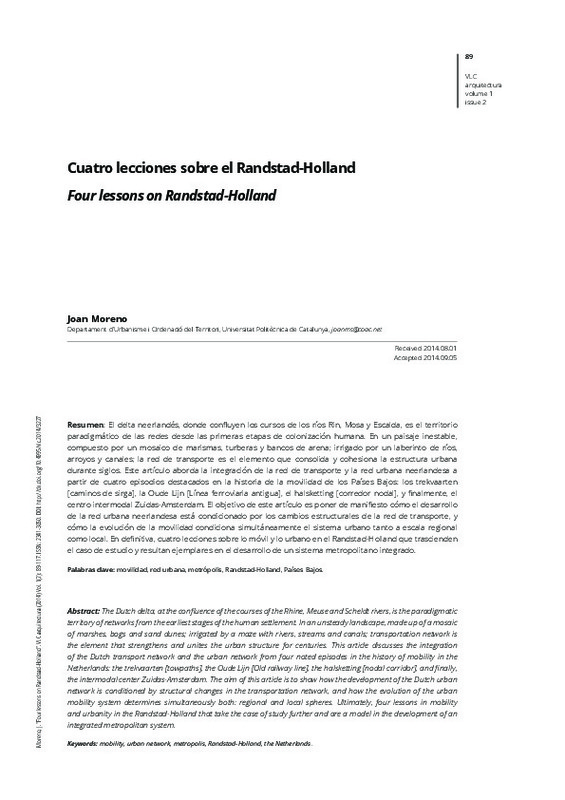JavaScript is disabled for your browser. Some features of this site may not work without it.
Buscar en RiuNet
Listar
Mi cuenta
Estadísticas
Ayuda RiuNet
Admin. UPV
Four lessons on Randstad-Holland
Mostrar el registro sencillo del ítem
Ficheros en el ítem
| dc.contributor.author | Moreno, Joan
|
|
| dc.date.accessioned | 2014-11-20T11:01:16Z | |
| dc.date.available | 2014-11-20T11:01:16Z | |
| dc.date.issued | 2014-10-23 | |
| dc.identifier.issn | 2341-3050 | |
| dc.identifier.uri | http://hdl.handle.net/10251/44485 | |
| dc.description.abstract | [EN] The Dutch delta, at the confluence of the courses of the Rhine, Meuse and Scheldt rivers, is the paradigmatic territory of networks from the earliest stages of the human settlement. In an unsteady landscape, made up of a mosaic of marshes, bogs and sand dunes; irrigated by a maze with rivers, streams and canals; transportation network is the element that strengthens and unites the urban structure for centuries. This article discusses the integration of the Dutch transport network and the urban network from four noted episodes in the history of mobility in the Netherlands: the Trekvaarten [towpaths], the Oude Lijn [Old railway line], the Halsketting [nodal corridor], and finally, the intermodal center Zuidas-Amsterdam. The aim of this article is to show how the development of the Dutch urban network is conditioned by structural changes in the transportation network, and how the evolution of the urban mobility system determines simultaneously both: regional and local spheres. Ultimately, four lessons in mobility and urbanity in the Randstad-Holland that take the case of study further and are a model in the development of an integrated metropolitan system. | en_EN |
| dc.description.abstract | [ES] El delta neerlandés, donde confluyen los cursos de los ríos Rin, Mosa y Escalda, es el territorio paradigmático de las redes desde las primeras etapas de colonización humana. En un paisaje inestable, compuesto por un mosaico de marismas, turberas y bancos de arena; irrigado por un laberinto de ríos, arroyos y canales; la red de transporte es el elemento que consolida y cohesiona la estructura urbana durante siglos. Este artículo aborda la integración de la red de transporte y la red urbana neerlandesa a partir de cuatro episodios destacados en la historia de la movilidad de los Países Bajos: los trekvaarten [caminos de sirga], la Oude Lijn [Línea ferroviaria antigua], el Halsketting [corredor nodal], y finalmente, el centro intermodal Zuidas-Ámsterdam. El objetivo de este artículo es poner de manifiesto cómo el desarrollo de la red urbana neerlandesa está condicionado por los cambios estructurales de la red de transporte, y cómo la evolución de la movilidad condiciona simultáneamente el sistema urbano tanto a escala regional como local. En definitiva, cuatro lecciones sobre lo móvil y lo urbano en el Randstad-Holland que trascienden el caso de estudio y resultan ejemplares en el desarrollo de un sistema metropolitano integrado. | es_ES |
| dc.language | Español | |
| dc.language | Inglés | |
| dc.publisher | Editorial Universitat Politècnica de València | |
| dc.relation.ispartof | VLC arquitectura. Research Journal | |
| dc.rights | Reconocimiento - No comercial (by-nc) | |
| dc.subject | Movilidad | es_ES |
| dc.subject | Red urbana | es_ES |
| dc.subject | Metrópolis | es_ES |
| dc.subject | Randstad-Holland | |
| dc.subject | Países Bajos | es_ES |
| dc.subject | Mobility | en_EN |
| dc.subject | Urban network | en_EN |
| dc.subject | The Netherlands | en_EN |
| dc.title | Four lessons on Randstad-Holland | |
| dc.title.alternative | Cuatro lecciones sobre el Randstad-Holland | es_ES |
| dc.type | Artículo | |
| dc.date.updated | 2014-11-20T11:01:13Z | |
| dc.identifier.doi | 10.4995/vlc.2014.3227 | |
| dc.rights.accessRights | Abierto | |
| dc.description.bibliographicCitation | Moreno, J. (2014). Four lessons on Randstad-Holland. VLC arquitectura. Research Journal. 1(2):89-117. https://doi.org/10.4995/vlc.2014.3227 | es_ES |
| dc.description.accrualMethod | SWORD | es_ES |
| dc.relation.publisherversion | https://doi.org/10.4995/vlc.2014.3227 | |
| dc.description.upvformatpinicio | 89 | |
| dc.description.upvformatpfin | 117 | |
| dc.type.version | info:eu-repo/semantics/publishedVersion | |
| dc.description.volume | 1 | |
| dc.description.issue | 2 | |
| dc.identifier.eissn | 2341-2747 | |
| dc.description.references | ALPERS, Svetlana. The art of describing: Dutch art in the seventeenth century. Chicago: The University of Chicago Press, 1984. 273 p. ISBN: 02-2601-513-0 | es_ES |
| dc.description.references | Bouwer, I. "Fixing the link: creating a strong, vital and attractive link between the Dutch central railway station and city centre". Director: Remon Rooij, Stevan van der Spek. Tesis de master. Delft university of technology, Nederlandse Spoorwegen, 2010. 249 p. | es_ES |
| dc.description.references | Glaudemans, M. Amsterdams Arcadia: de ontdekking van het acherland. Nijmegen: SUN, 2000, 198 p. ISBN: 978-90-6168-587-6 | es_ES |
| dc.description.references | Hall, P.; Pain, Kathy. Polycentric metropolis: learning from mega-city regions in Eu-rope. London: Earthscan, 2006. 228 p. ISBN: 978-18-4407-329-0 | es_ES |
| dc.description.references | Speet, B. Historische atlas van Amsterdam: van veendorp tot hoofdstad. Ámsterdam: SUN, 2010, 80 p. ISBN: 978-90-8506-5586 | es_ES |
| dc.description.references | Steenbergen, C.; Reh, Wouter; Nijhuis, Steffen; Pouderoijen, Michiel. The polder atlas of the Netherlands: pantheon of the lowlands. Bussum (Nederland): Thoth Publis-hers, 2012. 624 p. ISBN: 978-90-6868-519-0 | es_ES |
| dc.description.references | Veenendaal, G. Spoorwegen in Nederland: van 1834 tot nu [Ferrocarril en Nederland: desde 1834 hasta la actualidad]. Amsterdam: Boom, 2004. 604 p. ISBN: 90-5352-980-2 | es_ES |








